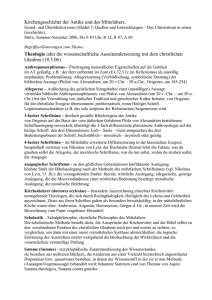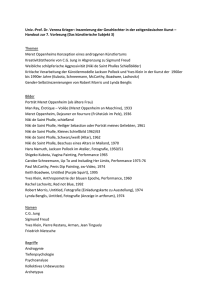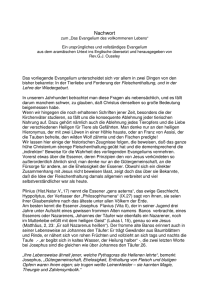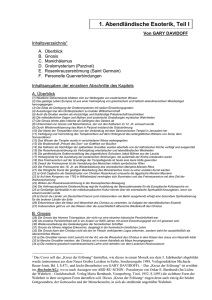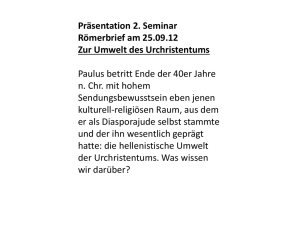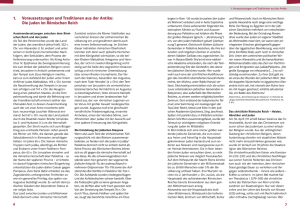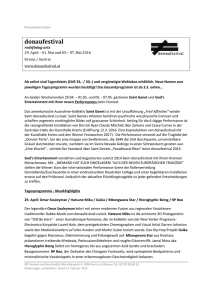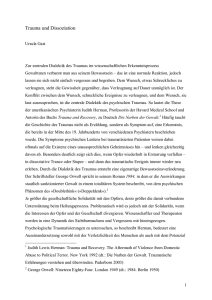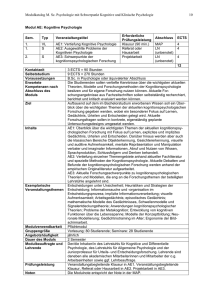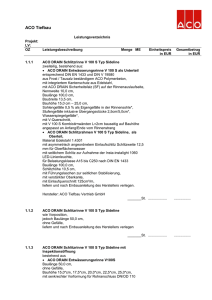1 - Documenta Catholica Omnia
Werbung
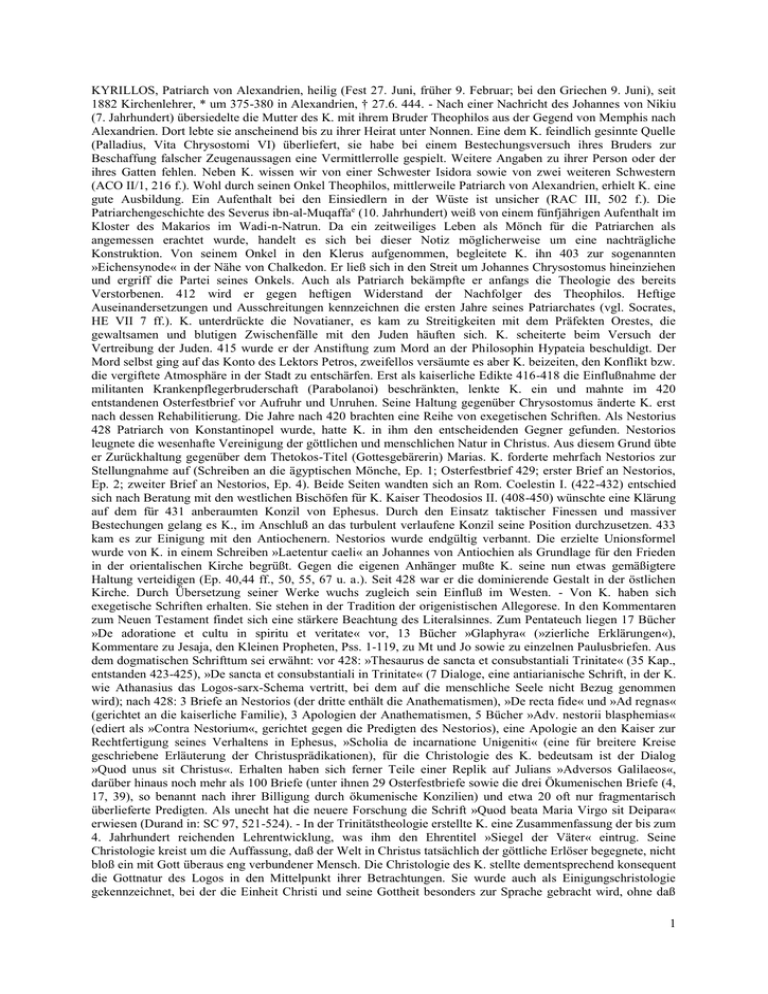
KYRILLOS, Patriarch von Alexandrien, heilig (Fest 27. Juni, früher 9. Februar; bei den Griechen 9. Juni), seit 1882 Kirchenlehrer, * um 375-380 in Alexandrien, † 27.6. 444. - Nach einer Nachricht des Johannes von Nikiu (7. Jahrhundert) übersiedelte die Mutter des K. mit ihrem Bruder Theophilos aus der Gegend von Memphis nach Alexandrien. Dort lebte sie anscheinend bis zu ihrer Heirat unter Nonnen. Eine dem K. feindlich gesinnte Quelle (Palladius, Vita Chrysostomi VI) überliefert, sie habe bei einem Bestechungsversuch ihres Bruders zur Beschaffung falscher Zeugenaussagen eine Vermittlerrolle gespielt. Weitere Angaben zu ihrer Person oder der ihres Gatten fehlen. Neben K. wissen wir von einer Schwester Isidora sowie von zwei weiteren Schwestern (ACO II/1, 216 f.). Wohl durch seinen Onkel Theophilos, mittlerweile Patriarch von Alexandrien, erhielt K. eine gute Ausbildung. Ein Aufenthalt bei den Einsiedlern in der Wüste ist unsicher (RAC III, 502 f.). Die Patriarchengeschichte des Severus ibn-al-Muqaffae (10. Jahrhundert) weiß von einem fünfjährigen Aufenthalt im Kloster des Makarios im Wadi-n-Natrun. Da ein zeitweiliges Leben als Mönch für die Patriarchen als angemessen erachtet wurde, handelt es sich bei dieser Notiz möglicherweise um eine nachträgliche Konstruktion. Von seinem Onkel in den Klerus aufgenommen, begleitete K. ihn 403 zur sogenannten »Eichensynode« in der Nähe von Chalkedon. Er ließ sich in den Streit um Johannes Chrysostomus hineinziehen und ergriff die Partei seines Onkels. Auch als Patriarch bekämpfte er anfangs die Theologie des bereits Verstorbenen. 412 wird er gegen heftigen Widerstand der Nachfolger des Theophilos. Heftige Auseinandersetzungen und Ausschreitungen kennzeichnen die ersten Jahre seines Patriarchates (vgl. Socrates, HE VII 7 ff.). K. unterdrückte die Novatianer, es kam zu Streitigkeiten mit dem Präfekten Orestes, die gewaltsamen und blutigen Zwischenfälle mit den Juden häuften sich. K. scheiterte beim Versuch der Vertreibung der Juden. 415 wurde er der Anstiftung zum Mord an der Philosophin Hypateia beschuldigt. Der Mord selbst ging auf das Konto des Lektors Petros, zweifellos versäumte es aber K. beizeiten, den Konflikt bzw. die vergiftete Atmosphäre in der Stadt zu entschärfen. Erst als kaiserliche Edikte 416-418 die Einflußnahme der militanten Krankenpflegerbruderschaft (Parabolanoi) beschränkten, lenkte K. ein und mahnte im 420 entstandenen Osterfestbrief vor Aufruhr und Unruhen. Seine Haltung gegenüber Chrysostomus änderte K. erst nach dessen Rehabilitierung. Die Jahre nach 420 brachten eine Reihe von exegetischen Schriften. Als Nestorius 428 Patriarch von Konstantinopel wurde, hatte K. in ihm den entscheidenden Gegner gefunden. Nestorios leugnete die wesenhafte Vereinigung der göttlichen und menschlichen Natur in Christus. Aus diesem Grund übte er Zurückhaltung gegenüber dem Thetokos-Titel (Gottesgebärerin) Marias. K. forderte mehrfach Nestorios zur Stellungnahme auf (Schreiben an die ägyptischen Mönche, Ep. 1; Osterfestbrief 429; erster Brief an Nestorios, Ep. 2; zweiter Brief an Nestorios, Ep. 4). Beide Seiten wandten sich an Rom. Coelestin I. (422-432) entschied sich nach Beratung mit den westlichen Bischöfen für K. Kaiser Theodosios II. (408-450) wünschte eine Klärung auf dem für 431 anberaumten Konzil von Ephesus. Durch den Einsatz taktischer Finessen und massiver Bestechungen gelang es K., im Anschluß an das turbulent verlaufene Konzil seine Position durchzusetzen. 433 kam es zur Einigung mit den Antiochenern. Nestorios wurde endgültig verbannt. Die erzielte Unionsformel wurde von K. in einem Schreiben »Laetentur caeli« an Johannes von Antiochien als Grundlage für den Frieden in der orientalischen Kirche begrüßt. Gegen die eigenen Anhänger mußte K. seine nun etwas gemäßigtere Haltung verteidigen (Ep. 40,44 ff., 50, 55, 67 u. a.). Seit 428 war er die dominierende Gestalt in der östlichen Kirche. Durch Übersetzung seiner Werke wuchs zugleich sein Einfluß im Westen. - Von K. haben sich exegetische Schriften erhalten. Sie stehen in der Tradition der origenistischen Allegorese. In den Kommentaren zum Neuen Testament findet sich eine stärkere Beachtung des Literalsinnes. Zum Pentateuch liegen 17 Bücher »De adoratione et cultu in spiritu et veritate« vor, 13 Bücher »Glaphyra« (»zierliche Erklärungen«), Kommentare zu Jesaja, den Kleinen Propheten, Pss. 1-119, zu Mt und Jo sowie zu einzelnen Paulusbriefen. Aus dem dogmatischen Schrifttum sei erwähnt: vor 428: »Thesaurus de sancta et consubstantiali Trinitate« (35 Kap., entstanden 423-425), »De sancta et consubstantiali in Trinitate« (7 Dialoge, eine antiarianische Schrift, in der K. wie Athanasius das Logos-sarx-Schema vertritt, bei dem auf die menschliche Seele nicht Bezug genommen wird); nach 428: 3 Briefe an Nestorios (der dritte enthält die Anathematismen), »De recta fide« und »Ad regnas« (gerichtet an die kaiserliche Familie), 3 Apologien der Anathematismen, 5 Bücher »Adv. nestorii blasphemias« (ediert als »Contra Nestorium«, gerichtet gegen die Predigten des Nestorios), eine Apologie an den Kaiser zur Rechtfertigung seines Verhaltens in Ephesus, »Scholia de incarnatione Unigeniti« (eine für breitere Kreise geschriebene Erläuterung der Christusprädikationen), für die Christologie des K. bedeutsam ist der Dialog »Quod unus sit Christus«. Erhalten haben sich ferner Teile einer Replik auf Julians »Adversos Galilaeos«, darüber hinaus noch mehr als 100 Briefe (unter ihnen 29 Osterfestbriefe sowie die drei Ökumenischen Briefe (4, 17, 39), so benannt nach ihrer Billigung durch ökumenische Konzilien) und etwa 20 oft nur fragmentarisch überlieferte Predigten. Als unecht hat die neuere Forschung die Schrift »Quod beata Maria Virgo sit Deipara« erwiesen (Durand in: SC 97, 521-524). - In der Trinitätstheologie erstellte K. eine Zusammenfassung der bis zum 4. Jahrhundert reichenden Lehrentwicklung, was ihm den Ehrentitel »Siegel der Väter« eintrug. Seine Christologie kreist um die Auffassung, daß der Welt in Christus tatsächlich der göttliche Erlöser begegnete, nicht bloß ein mit Gott überaus eng verbundener Mensch. Die Christologie des K. stellte dementsprechend konsequent die Gottnatur des Logos in den Mittelpunkt ihrer Betrachtungen. Sie wurde auch als Einigungschristologie gekennzeichnet, bei der die Einheit Christi und seine Gottheit besonders zur Sprache gebracht wird, ohne daß 1 jedoch darüber die Menschheit Christi aufgegeben wird. Die unscharfe Begrifflichkeit des K., in Unkenntnis der Terminologie des Apollinaris entnommen, sorgte für Mißverständnisse (mia physis Lehre). Der Theotokostitel Mariens war weniger eine dogmatische Aussage, er diente in erster Linie zur Betonung der Einheit in Christus. K. verwendete in diesem Zusammenhang auch die Vorstellung von der Idiomenkommunikation. Quellen: ACO I; Cod. Vaticanus gr. 1431, eine antichalkedon. Sammlung aus der Zeit Kaiser Zenos, hrsg. von Eduard Schwartz, Berlin 1927; Evagrius Scholasticus, HE, hrsg. von J. Bidez/L. Parmentier, London 1898, Kap. 1; Johannes von Nikiu, Weltchronik, hrsg. von H. Zotenberg, Paris 1935 2, Kap. 78, 87, 92; Nestorios, Liber Heraclidis, hrsg. von J. Bedjan, Paris 1920; Severus ibn al-Muqaffae, Historia Patriarchorum, in: PO I/11.12; Socrates, HE, hrsg. von R. Hussey, 3 Bde., Oxford 1853, Kap. 7; Vita C. coptica, hrsg. von Tito Orlandi, in: Storia della Chiesa di Alessandrina, Mailand 1970. Werke: Mauritius Geerard, Clavis Patrum Graecorum, III, Turnhout 1979, 5200-5438; J. Aubert (Hrsg.), Opera, 6 Bde., Paris 1638 (= Migne PG LXVIII-LXXVII); Philip E. Pusey (Hrsg.), Opera, 7 Bde., Oxford 1868-1877 (Nachdr. Brüssel 1965); Apologeticus ad imperatorem, in: ACO I/1/5, 75-90; Commentarius in XII Prophetas, in: Pusey I-II; Commentarius in Isaiam, in: Migne PG LXX, 9-1450; Commentarius in Ioannem, in: Pusey III-V, 172 (engl. von P. E. Pusey/E. Randell, 2 Bde., Oxford 1882-1885); Commentarius in Lucam, in: Migne PG LXXII, 475-950, LXXVII, 1006-1016, 1039-1050 (syr. mit engl. Übers. von R. Payne Smith, 2 Bde., Oxford 1858/1859, Nachdr. Astoria N.Y. 1983), Kap. 1-80, in: CSCO LXX (1912), lat., in: CSCO 140 (1953), siehe auch: J. M. Sauget, in: OrChrA 197 (1972), 438-456; Contra Anthropomorphitas, in: Migne PG LXXVI, 10651132; Contra Julianum, in: Migne PG LXXVI, 509-1064 (frz. in: SC 322 (1985), 101-319, hrsg. von Paul Búrguière und Pierre Evieux); Contra Nestorium, in: ACO I/1/6, 13-106 (engl. P. E. Pusey, in: LoF 47 (1881), 1104); De adoratione, in: Migne PG LXVIII, 133-1125; De dogmatum solutione, in: Pusey V, 549-602; De incarnatione, hrsg. von G. M. Durand, in: SC 97 (1964), 188-301 (dt. in: BKV1 (1879), 471-528); De recta fide ad Arcadiam et Marinam, in: ACO I/15, 26-61; De recta fide ad Theodosium, in: ACO I/1/1, 42-74 (dt. in: BKV2 12 (1935), 21-78, neu hrsg. von Bernhard M. Weischer, München 1984); De trinitate dialogi, hrsg. von G. M. Durand, 3 Bde., Paris 1976-1978, (= SC 231/237/246); Duodecim capitum defensio, in: ACO I/1/7, 33-65; Epistula ad Euoptium, in: ACO I/1/6, 107-146; Epistulae, in: Migne PG LXXVII, 401-481 (etl. Briefe auch in ACO), engl. Auswahl, in: CSCO 359/360, 1975, ep. 55: dt. in: BKV 2 12 (1935), 237-263, ökum. Briefe, in: ACO I/1, 25-28, 33-42, I/1/4, 15-20, engl. in: P. E. Pusey, Oxford 1879 und J. Stevenson, Creeds, councils and controversies, London 1966, 279-294, dt.: BKV2 12 (1935), 79-108, vgl. ferner: L. R. Wickham, Selected letters, Oxford 1983, dt. Auswahl, hrsg. von Bernd M. Weischer, Wiesbaden 1979; Explicatio duodecim capitum, in: ACO I/1/5, 15-25; Fragmenta contra Diodorum et Theodorum, in: Pusey V, 493-537; Fragmenta in N.T., in: Pusey V, 173-440; Fragmenta in V.T., in: Migne PG LXIX, 679-1294, 1451-1462; Glaphyra in Pentateuchum, in: Migne PG LXIX, 9-678; Homiliae diversae, in: Migne PG LXXVII, 981-1116 (etl. auch in ACO), niederl.: M. Costanza, C. va. A. Preeken, Busum 1946, hom. 4 dt., in: O. Bardenhewer, Marienpredigten, München 1934; Homiliae paschales, in: Migne PG LXXVII, 401-982, hom. 8 und 17, in: M. Costanza, a.a.O., 21-66 (niederl.); Quod B.M.V. sit Deipara, in: ACO I/1/7, 19-32, dt. in: BKV2 12 (1935), 205-236; Quod unus sit Christus, in: G. M. Durand (Hrsg.), Paris 1964 (= SC 97, 302-515), dt. in: BKV2 12 (1935), 109-204; Responsio ad Tiberium, in: Pusey V, 576-602, syr. mit engl. Übers., in: Muséon 83 (1970), 433- 482; Scholia de incarnatione, in: ACO I/5, 184-231, lat. in: Pusey VI, 498-579, armen. mit engl. Übers.: F. C. Conybeare, The Armenian version of revelation and C. of A.'s Scholia, London 1907, 96-143, 165-214; Thesaurus de Trinitate, in: Migne PG LXXV, 9-636; Verschiedene Werke erschienen in poln. Übers.: Sw. C. Aleksandryjski. Wyklad prawdziwej wiary. Wobronic tytulu Bogoradzica, Homilie efeskie (= De recta fide, Adversus nolentes conflicti sanctam Virginem est Deiparam, Homiliae 1-7 Ephesi habitae), hrsg. von W. Kania/E. Stanula/St. Kalinkowski, Warschau 1980; Über den rechten Glauben. Memorandum an den Kaiser. Drei Briefe. Erklärung des Glaubensbekenntnisses, hrsg. von Bernd M. Weischer, München 1984; Letters, transl. by John J. McEnerny, Washington 1987 (Letters 1-50), 1989 (Letters 51-100). Lit.: Joseph Kopallik, C. von Alexandrien. Eine Biographie nach den Quellen, Mainz 1881; - Hermann Schrader, Zu den Fragmenten der Philosophiae Historia des Porphyrius bei C. von Alexandrien, in: AGPh 1 (1888), 359374; - Albert Ehrhard, Eine unechte Marienhomilie des hl. C. von Alexandrien, in: RQ 3 (1889), 97-113; - A. Largent, Etudes d'histoire ecclésiastique, Paris 1892, 1-73; - P. Schäfer, Die Christologie des hl. C. von Alexandrien in der röm. Kirche, in: ThQ 77 (1895), 421-447; - A. Rehrmann, Die Christologie des hl. C. von Alexandrien syst. dargest., Hildesheim 1902; - Eduard Weigl, Die Heilslehre des hl. C. von Alexandrien, Mainz 1905; - Johannes Scharnagl, Sancti C. XVII homiliae sive epistulae paschalis interpretatio quae vulgo Arnobii Junioris dicitur latina, Wien 1909 (zuerst: Jahresber. des k.u.k. Staatsgymnasiums im 3. Bezirk); - F. Nau, St. C. et Nestorius, in: Revue de l'Orient Chrétien 15 (1910), 365-391; - Adolf Struckmann, Die Eucharistielehre des hl. C. von Alexandrien, Paderborn 1910; - Adolf Ruecker, Die Lukas-Homilien des hl. C. von Alexandrien, Leipzig 1911; - M. Jugie, La terminologie des S. C. d'Alexandrie, in: EO 15 (1912), 12-27; - Ders., Nestorios et la controverse nestorienne, Paris 1912, 174-190; - Pierre Batiffol, Les présence de S. C. à la cour de Constantinoples, in: Ders., Etudes de liturgie et d'archéologie chrétienne, Paris 1919, 154-179; - Adolf Eberle, Die Mariologie des hl. C. von Alexandrien, Freiburg 1921; - Johann Nepomuk Hebensperger, Die Denkwelt des 2 hl. C. von Alexandrien. Eine Analyse ihres philos. Ertrags, Augsburg 1927; - Eduard Schwartz, C. und der Mönch Victor, Wien 1928; - Adhémar d'Alès, Le symbole d'union de 433, in: RSR 21 (1931), 257-268; - J. Lebon, Autour de la définition de foi du Concile d'Ephèse, in: EThLov 8 (1931), 393-412; - Adhémar d'Alès, S. C. d'Alexandrie et les sept à St. Marie d'Ephèse, in: RSR 22 (1932), 62-70; - C. Papadopulos, S. C. d'Alexandrie, Alexandria 1933 (griech.); - J. Puig de la Bella Casa, Los doce anatematismos de S. C. fueron aprobados por el Concilio de Efeso?, in: Estudios eclesiásticos 11 (1933), 5-25; - Johannes B. Wolf, Commentationes in S. C. Alexandrini de Spiritu Sancto doctrinam, Diss. Rom 1934; - Marcel Richard, Une homélie de Théophile d'Alexandrie, in: RHE 33 (1937), 45-56; - A. Vaccari, La grecità di S. C. d'Alessandria, in: Studi dedicati alla memoria di P. Ubaldi, Mailand 1937, 27-40; - J. van den Dries, The formula of St. C. of Alexandria , Diss. Pont. Univ. Gregoriana, Rom 1939 (gedr. London 1940); A. M. Dubarle, L'ignorance du Christ chez S. C., in: EThLov 16 (1939), 110-119; - S. Stenger, C. von Alexandrien über den Hl. Geist, in: Benediktinische Monatsschrift 21 (1939), 159-172; - Robert Victor Sellers, Two ancient christologies, London 1940; - H. du Manoir de Jouaye, Dogme et spiritualité chez S. C. d'Alexandrie, Paris 1944; - O. Z. Hopfner/Georges Jouassard, L'activité littéraire de S. C. d'Alexandrie jusqu'à 428, in: Mélanges E. Podechard, Lyon 1945, 148-176; - Kyrilliana. Spicilegia ed. S. C. Alexandrini XV recurrente saeculo (444-1944), Kairo 1947; - A. Hulsbosch, De hypostatische vereniging volgens de H. C. van Alexandrie, in: Studia Catholica (Nijmegen) 24 (1949), April, 65-94; Gualbertus Matteucci, »Kyrilliana«. In onore di S. C. d'Alessandria per il XV centenario della sua morte, in: Antonianum 24 (1949), 352-359; - N. Charlier, Le »Thesaurus de Trinitate« de S. C., in: RHE 45 (1950), 25-81; - N. M. Haring, The character and range of the influence of St. C. of Alexandria on Latin Theology (430-1260), in: Mediaeval Studies 12 (1950), 119; - Henry Chadwick, Eucharist and christology in the nestorian controversy, in: JTHS N.S. 2 (1951), 145-164; - Jacques Liébaert, La doctrine christologique de saint C. d'Alexandrie avant la querelle nestorienne, Lille 1951; - P. Galtier, L'»Unio secundum Hypostasim« chez saint C., in: Gregorianum 33 (1952), 351-398; - Alexander Herrigan, St. C. of Alexandria, interpreter of the Old Testament, Rom 1952; - Marcel Richard, Le pape Léon le grand et les »Scholia de Incarnatione Unigeniti« di S. C., in: RSR 40 (1952), 116-128; - P. Galtier, Le Saint Esprit dans l'incarnation du verbe d'apres saint C. d'Alexandrie, in: Problemi scelti di teologia contemporanea. Relazioni lette nella Sezione di Teologia de Congresso Internazionale per il IV Centenario della Pont. Uiv. Gregoriana 13-17 ottobre 1953, Rom 1954, 383-392; - Luise Abramowski, Der Streit um Diodor und Theodor zwischen den beiden ephesinischen Konzilien, in: ZKG 67 (1955/1956), 252-287; - Bernard Fraigneau-Julien, L'efficacité de l'humanité du Christ selon saint C. d'Alexandrie, in: Revue Thomiste 55 (1955), 615-628;Georges Jouassard, Un problème d'anthropologie et de christologie chez saint C. d'Alexandrie, in: RSR 43 (1955), 361-378; - Jacques Liébaert, Saint C. d'Alexandrie et la culture antique, in: MSR 12 (1955), 5-26; Ciriaco Sacanzillo, Intorno al dialogo »Quod Christus sit unus« di C. di Alessandria, in: Divus Thomas 59 (1956), 218-229 (zuerst in: Duc in Altum (Tlalpan/Mexiko) 20 (1955), 3-19); - Hans von Campenhausen, Die griech. Kirchenväter, Stuttgart 19562, 153-164; - A. Cordoliani, Textos de Computo español del siglo VI. El »Prologus C.«, in: Hispania sacra (Madrid) 9 (1956), 127-140; - Herman M. Diepen, La christologie de S. C. d'Alexandrie et l'anthropologie néoplatonicienne. Un trait de la physionomie spirituelle d'un grand archêveque, in: Euntes docete 9 (1956), Nr. 1-3, 20-63; - Bernard Fraigneau-Julien, L'inhabitation de la Sainte Trinité dans l'âme selon Saint C. d'Alexandrie, in: RSR 30 (1956), 135-156; - P. Galtier, Saint C. et Apollinaire, in: Gregorianum 37 (1956), 584-609; - Georges Joussard, Saint C. d'Alexandrie et le schéma de l'incarnation verbechair, in: RSR 44 (1956), 234-242; - M. Lacko, L'épiscopat de S. C. dans le Codex Vaticanus Lat. 9668, in: OrChrP 22 (1956), 368-388; - Gilles Langevin, Le thème de l'incorruptibilité dans le commentaire de saint C. d'Alexandrie sur l'Evangile selon saint Jean, in: Sciences ecclésiastiques (Montréal) 8 (1956), 295-316; - Benoît Lavand/Herman Diepen, Saint C. d'Alexandrie. Court traité contre ceux qui ne veulent pas reconnaître Marie Mère de Dieu, in: RThom 56 (1956), 688-712; - Ciriaco Scanzillo, Intorno al dialogo »Quod Christus sit unus« di S. C. d'Alessandria, in: DTh 59 (1956), 218-229; - Walter J. Burghardt, The image of God in man according to C. of Alexandria, Diss. Washington, Woodstock 1957; - José Capmany, La Communicacíon del Espíritu Santo a la Iglesia cuerpo místico, como principio de su unidad, según sa C. de Alejandría, in: Revista española de Teología (Madrid) 17 (1957), 173-204; - N. Charlier, La doctrine sur le Saint' Esprit dans le »Thesaurus« de saint C. d'Alexandrie, in: StP II, Berlin 1957, 187-193; - Herman M. Diepen, Aux origines de l'anthropologie de saint C. d'Alexandrie, Brügge 1957; - Ders., Stratagèmes contre la théologie de l'Emmanuel. Apropos d'une nouvelle comparaison entre S. C. de Apollinaire, in: Divinitas 1,3 (1957), 479-529; - Georges Joussard, »Impassibilité« du Logos et »impassibilité« de l'âme humaine chez saint C. d'Alexandrie, in: RSR 45 (1957), 209-224; - A. Kerrigan, The objects of the literal and spiritual senses of the New Testament according to St. C. of Alexandria, in: StP I, Berlin 1957, 354-374; - S. Trooster, De Heilige Geest en de menswording bij C. van Alexandrie, in: Bijdragen 18 (1957), 375-397; - Augustin Dupré la Tour, »Doxa« dans le commentaires exégétiques de C. d'Alexandrie, Diss. Gregoriana, Rom 1958; - L. Leahy, L'inhabitation d'après saint C. Alexandrie, in: Sciences ecclésiastiques 11 (1959), 201-212; - Carlo Molari, La cristologia di S. C. e l'antropologia neoplatonica, in: Euntes docete 12 (1959), 223-229; - Hugo Rahner, Österl. Frühlingslyrik bei K. von Alexandrien, in: Paschatis sollemnia, hrsg. von Balthasar Fischer und Johannes Wagner, Freiburg 1959, 683 75; - Ciriaco Scanzillo, La prima lettera e gli »Scholia de Incarnatione Unigeniti« di S. C. di Alessandria, in: Asprenas (Neapel) 6 (1959), 257-287; - Augustin Dupré la Tour, La Doxa du Christi dans les œuvres exégétiques de saint C. d'Alexandrie, in: RSR 48 (1960), 521-543, 49 (1961), 68-94; - W. C. H. Driessen, Un commentaire arménien d'Ezéchiel faussement attribué â saint C. d'Alexandrie, in: Rivista Biblica 68 (1961), 251261; - Bernard Fraigneau-Julien, Un traité anonyme de la Sainte Trinité attribué à saint C. d'Alexandrie, in: RSR 49 (1961), 188-211, 386-405; - J. Meyendorff, ' (Rom 5,12) chez C. d'Alexandrie et Theodoret, in: StP IV, Berlin 1961, 157-161; - L. M. Armendáriz, El nuevo Moisés. Dinámica cristocéntrica en la tipología de C. de Alejandría, Madrid 1962; - Georges Jouassard, Sainte C. d'Alexandrie aux prises avec la »communication des idiomes« avant 428 dans ses ouvrages antiariens, in: StP VI, Berlin 1962, 112-121, - A. M. Bermejo, The indwelling of the Holy Spirit according to saint C. Alexandria, Ona 1963; - O. Blanchette, Saint C. of Alexandria's idea of the redemption, in: Sciences ecclésiastiques 16 (1964), 455-480; - G. M. Durand, C. d'Alexandrie, Deux dialogues christologiques, Paris 1964; - R. M. Grant, Greek literature in the treatise »De Trinitate« and C.'s »Contra Julianum«, in: JThS 15 (1964), 265-279; - W. J. Malley, The »Contra Julianum« of St. C. of Alexandria and St. Peter Canisius, in: ThSt 25 (1964), 70-74; - Ewald Nacke, Das Zeugnis der Väter in der theol. Beweisführung C.'s von Alexandrien nach seinen Briefen und antinestorian. Schriften, Diss. Münster 1964; - J. S. Romanides, St. C.'s »One physis or hypostasis of God the Logos incarnate« and Chalcedon, in: The Greek Orthodox Theological Review (Brookline/Mass.) 10 (1964/1965), 82-107; - V. C. Samuel, One incarnate nature of God the word, in: ebd., 37-53; - Jacques Liébaert, Christologie, in: Handb. der Dogmengesch., III/1, Freiburg 1965, 104-118; - R. Rosini, Il Primogenito in S. C. di Alessandria, in: Studia Patavina 12 (1965), 32-64; - Joseph Sauer, Die Exegese des C. von Alexandrien nach seinem Kommentar zum Johannes-Evangelium. Mit Berücks. der Beziehungen zur Origenes und Athanasius, Diss. Freiburg 1965; - Marcel Richard, Deux lettres perdues de C. d'Alexandrie, in: StP VII, Berlin 1966, 274-277; - Ciriaco Scanzillio, Lineamenti dell'argomentazione teologica di S. C. di Alessandria nei trattati alla corte imperiale, in: Asprenas 13 (1966), 275-294; - Bernhard Weischer, C. von Alexandrien. Der Dialog »Daß Christus Einer ist«, Diss. Bonn 1966; Robert Wilken, Exegesis and the history of theology: Reflections on the Adam-Christ typology in C. of Alexandria, in: Church History (Hartford/Conn. und Chicago) 35 (1966), 139-156; - Constantine Dratsellas, Questions of the soterological teaching of the greek fathers. With special reference to St. C. of Alexandria, in: Theologia (Athen) 38 (1967), 57-608; 39 (1968), 192-230, 394-424, 621-644; - Tito Orlandi, Osservazioni critico-filologiche sull'Encomio di Athanasio di C. di Alessandria, in: Rivista degli Studi Orientali (Rom) 42 (1967), 329-342; - Bernhard Weischer, Der Dialog »Daß Christus Einer ist« des C. von Alexandrien, in: OrChr 51 (1967), 130-185, 52 (1968), 92-137; - J. Caraza, La doctrine eucharistique de S. C. d'Alexandrie (rum.), in: Studi teologice (Bukarest) 20 (1968), 528-542; - H. H. Holfelder, Zu Horaz, Ep. I,7,29-33 und C., Speculum sapientiae, III,11, in: Hermes 96 (1968/1969), 638-640;- F. M. Young, Christological ideas in the greek commentaries on the epistle to the Hebrews, in: JThS N.S. 20 (1969), 150-163; - R. Y. Ebied/L. R. Wickham, The letter of C. of Alexandria to Tiberius the deacon. Syriac version, in: Muséon 83 (1970), 433-482; - Jacques Liébaert, L'évolution de la christologie de S. C. d'Alexandrie à partir de la controverse nestorienne. La lettre pascale XVII et la lettre aux moines (428-429), in: MSR 27 (1970), 27-48; - Matei Pislaru, Saint C. le Patriarche d'Alexandrie et la philosophe Hypatia (rum.), in: Mitripolia Banatului (Timizoara) 20 (1970), 7-9, 485-504; - H. du Manoir, Les premiers versets du quatrième Evangile commentés par C. d'Alexandrie, in: Studia medievalia et mariologica P. Carolo Balic OFM dicata, Rom 1971, 101-119; - R. Y. Ebied/L. R. Wickham, An unknown letter of C. of Alexandria in Syriac, in: JThS 22 (1971), 420-434;- Gordon D. Fee, The text of John in Origen and C. of Alexandria. A contribution to methodology in the recovery and analysis of patristic citations, in: Bibl 52 (1971), 357-394; - Viorel Ionita, La christologie de Saint C. d'Alexandrie dans la perspective du dialogue avec les églises néocalcédoniennes (rum.), in: Orthodoxia (Bukarest) 23 (1971), 194-209; - Georg Langgärtner, Der Descensus ad Inferos in den Osterbriefen des C. von Alexandrien, in: Wegzeichen (FS Hermenegild M. Biedermann), hrsg. von Chr. Suttner und C. Patock, Würzburg 1971, 95-100; - Robert Louis Wilken, Judaism and the early christian mind. A study of C. of Alexandria's exegesis and theology, New Haven 1971; - M. Aubineau, Deux homélies de C. d'Alexandrie »De hypapante« (BHG 1958 et 1963) ?, in: AnBoll 90 (1972), 100; - Timotei-Traian Seciciu, La christologie de Saint C. d'Alexandrie à la lumière des tendences actuelles de rapprochement entre l'Eglise orthodoxe et les anciennes églieses orientales, Diss. (rum.), in: Mitropolia Banatului (Timizoara) 22 (1972), 325-362; - Elena Cavalcanti, Spirito di verità - Somiglianza del Figlio nel Dialogo VII: De spiritu sancto di C. di Alessandria, in: Augustinianum 13 (1973), 589-598; - Timotei Seviciu, La doctrine christologique de Saint C. d'Alexandrie, Timisoara 1973 (rum.); - Ders., La valeur de la christologie de Saint C. d'Alexandrie dans le contexte de la théologie actuelle. La promotion de l'oecuménisme chrétien, in: Mitropolia Olteniei (Craiova) 25 (1973), 477-481 (rum.); - Arthur Vööbus, Discoveries of great import on the commentary on Luke by C. of Alexandria. The emergence of new manuscript sources for the Syriac version, Stockholm 1973; - Bernhard M. Weischer, Der Prosphonetikos »Über den rechten Glauben« des K. von Alexandrien an Theodosius II., Glückstadt 1973; - C. Datema, Une homélie inédite sur l'ascension, in: Byzantion 44 (1974), 121-137; - Pierre Evieux, André de Samosate. Un adversaire de C. d'Alexandrie durant la crise nestorienne, in: Revue des Etudes Byzantines 32 (1974), 253-300; - Ursula Knoben, C. von Alexandrien, in: 4 Lex. der christl. Ikonographie, hrsg. von Wolfgang Braunfels, VI, Rom-Freiburg 1974, 19-21; - John Joseph Lynch, Prosopon and the dogma of the Trinity. A study of the background of conciliar use of the word in the writings of C. of Alexandria and Leontius of Byzantium, Diss. Forham Univ. 1974; - E. P. Meijering, C. of Alexandria on the platonists and the Trinity, in: Nederlands theologisch tijdschrift (Wageningen) 20 (1974), 1629; - Ders., Some reflections on C. of Alexandria's rejection of anthropomorphism, in: ebd., 297-301; - Andreas Theodorou, La doctrine de C. d'Alexandrie et d'Epiphane de Chypre sur la procession du Saint Esprit, in: Theologia (Athen) 45 (1945), 80-101, 478-510 (griech.); - Constantin Dratsellas, Questions on Christology of St. C. of Alexandria, in: Abba Salama (Addis Abeba) 6 (1975), 203-232; - B. Forte, La dimensione cristologica, pneumatologica ed eucharistica della Chiesa nel »Commentario a Giovanni« di C. di Alessandria, in: Rivista di letteratura e di storia ecclesiastica 7 (1975), 357-398; - John J. Lynch, Leontios of Byzantium. A Cyrillian Christology, in: ThSt 36 (1975), 455-471; - E. P. Meijering, Some reflections on C. of Alexandria's rejection of anthropomorphism, in: Good being history. Studies in patristic philosophy, Oxford-Amsterdam-New York 1975, 128-132; - Ders., C. of Alexandria on the platonists and the Trinity, in: Ders., ebd., 114-127; - R. A. Norris, Christological models in C. of Alexandria, in: StP XIII, Berlin 1975, 255-268; - P. M. Parvis, The Commentary on Hebrews and the »Contra Theodorum« of C. of Alexandria, in: JThS 26 (1975), 415-419; - Ciriaco Scanzillo (Hrsg.), Trattato contra quelli che non vogliano riconoscere la Santa Vergine Madre di Dio, Sorrento 1975; - M. Santer, The authorship and occassion of C. of Alexandria. Sermon on the Virgin (Hom. Div. IV), in: StP XII, Berlin 1975, 144-150; - Thomas F. Torrance, The mind of Christ in worship. The problem of Apollinarianism in the liturgy, in: Theology in reconciliation, London 1975, 139-214; - C. E. Cox, C. of Alexandria's text for Deuteronomy, in: Bulletin of the International Organisation for Septuagint and Cognate Studies (Athens/Ga.) 10 (1977), 31-51; - Ezra Gebremedhin, Life-giving blessing. An inquiry into the eucharistic doctrine of C. of Alexandria, Stockholm 1977; - Georges Jouassard, La date des écrits antiariens de saint C. d'Alexandrie, in: RBén 87 (1977), 172-178; - Jacques Liébaert, Saint C. d'Alexandrie et l'unique prosopon du Christ. Aux origines de la controverse nestorienne, in: MSR 34 (1977), 49-62; - Jerry McCoy, Philosophical influences on the doctrine of the incarnation in Athanasius and C. of Alexandria, in: Encounter (Indianapolis) 38 (1977), 362-391; - Bojan Piperow, Sveti K. A. kato ekzeget, in: Duchovna Kultura (Sofia) 1 (1977), 9-13; - Marcel Richard, Deux lettres perdues de C. d'Alexandrie, in: Ders., Opera minora II, Turnhout 1977, Nr. 49; - Ders., Le Pape saint Léon le Grand et les »Scholia de Incarnatione Unigeniti« de saint C. d'Alexandrie, in: Ders., Opera minora II, a.a.O., Nr. 53; - Ders., Les traités de C. d'Alexandrie contre Diodore et Théodore et les fragments dogmatiques de Diodore de Tarse, in: Ders., Opera minora II, a.a.O., Nr. 51; - Manlio Simonetti, Note sul commento di C. di Alessandria ai Profeti minori, in: Vetera Christianorum 14 (1977), 301-330; - Bernd M. Weischer, Die Glaubenssymbole des Epiphanios von Salamis und des Gregorios Thaumaturgos im Qerellos, in: OrChr 61 (1977), 20-40; - G. Ferraro, Temporalità, escatologia e cristologia nel commento di C. di Alessandria al quatro vangelo. Aspetti di dottrina e di esegesi, in: Nicolaus 6 (1978), 47-86; - Stephen Gero, C. of Alexandria, image worship and the Vita of Rabban Hormized, in: OrChr 62 (1978), 77-97; - J.-M. Labelle, Saint C. d'Alexandrie témoin de la langue et de la pensée philosophiques au VI siècle, in: RSR 52 (1978), 135-158, 53 (1979), 23-42; William J. Malley, Hellenism and Christianity. The conflict between hellenism and Christian wisdom in the »Contra Galilaeos« of Julian the Apostate and the »Contra Julianum« of St. C. of Alexandria, Rom 1978; - Basil Studer, Soteriologie, in: Handb. der Dogmengesch. III/2, Freiburg 1978, 110-129; - Alois Grillmeier, Jesus der Christus im Glauben der Kirche, I, Freiburg 1979, 673 ff. (siehe auch 809, Reg.); - André de Halleux, C., Théodoret et le Filioque, in: RHE 74 (1979), 597-625; - F. J. Houdek, Contemplation in the life and works of S. C. of Alexandria, Diss. Los Angeles 1979; - Georg Söll, Mariologie (Gottesmutterschaft), in: Handb. der Dogmengesch. III/4, Freiburg 1979, 88-96; - B. de Margerie, L'exégèse christologique de saint C. d'Alexandrie, in: NRTh 102 (1980), 400-425; - Hans von Campenhausen, Griech. Kirchenväter, Stuttgart 1981 6, 153-164; André de Halleux, C. von Alexandrien, in: Heinrich Fries / Georg Kretschmar (Hrsg.), Klassiker der Theologie, I, München 1981, 130-149; - Paul Imhof/Bernd Lorenz, Maria Theotokos bei C. von Alexandrien. Zur Theotokos-Tradition und ihrer Relevanz, München 1981; - Yves Congar, Doctrines christologiques et théologie de l'eucharistie. Simples notes, in: RSPhTh 66 (1982), 233-244; - E. A. Clark, Claims on the bones of Saint Stephen. The partisans of melania and Eudocia, in: Church History 51 (1982), 141-156; - C. Datema, Classical quotations in the works of C. of Alexandria, in: StP XVII, Berlin 1982, I, 422-425; - G. Gharib, Il concilio di Efeso e la sua dottrina mariana, in: Nicolaus 10 (1982), 75-101; - E. R. Hardy, The further education of C. of Alexandria (412-444): Questions and problems, in: StP XVII, Berlin 1982, I, 116-122; - M. J. Rondeau, Les commentaires patristiques du Psautier (IIIe-Ve siècles). I: Les travaux des Pères grecs et latins sur le Psautier. Recherches et bilan, Rom 1982; - Manlio Simonetti, Alcune osservazioni sul monofisismo di C. di Alessandria, in: Augustinianum 22 (1982), 493-511; - Peter Stockmeier, Das Konzil von Chalkedon, in: FZPhTh 29 (1982), 140-156; - L. R. Wickham, Symbols of the incarnation in C. of Alexandrien, in: Typus, Symbol, Allegorie bei den östl. Vätern und ihren Parallelen im MA. Internat. Kolloquium Eichstätt 1981, hrsg. von Margot Schmidt und C. f. Geyer, Regensburg 1982, 41-53; - G. J. M. Bartelink, Homer in den Werken des K. von Alexandrien, in: Wiener Studien N.F. 17 (1983), 62-68; - J. P. Bouhot, Une lettre d'Augustin d'Hippone à C. d'Alexandrie, in: Les lettres de saint Augustin, découvertes par Johannes Divjak. Communications présentées au Colloque des 20 5 et 21 septembre 1982, Paris 1983, 147-154; - Anthony Daly, The fathers in the office of readings: St. C. of Alexandria, in: Review for Religions 42 (1983), 738-747; - M. A. Rossi, Osservazioni sul Commento ai Salmi di C. edito da Angelo Mai, in: Orpheus (Catania) 4 (1983), 116-124; - Manlio Simonetti, C. di Alessandria, in: Dizionario patristico e di antichità cristiana, hrsg. von Angelo Di Berardino, I, Casale Monferrato 1983, 691696; - V. Lambropoulou, Hypatia, the Alexandrian philosopher, in: Hypatia. Feminist studies (Athen) 1 (1984), 3-11; - M. A. Rossi, Ancora sul Commento ai Salmi di C. A. proposito di un recente lavoro sui commentari patristici al salterio, in: Analisti di storia dell'esegesi. Atti del 1° Seminario di ricerca su Storia dell'esegesi giudaica e cristiana antica, Idice di San Lazzaro (Bologna), 27-29 ottobre 1983, Bologna 1984, 45-51; - H. J. Vogt, C. von Alexandrien, in: Gestalten der Kirchengesch., hrsg. von Martin Greschat, II: Alte Kirche 2, Stuttgart 1984, 227-238; - L. R. Wickham, C. of Alexandria and the apple of discord, in: StP XV, Berlin 1984, 379-392; - H. J. Vogt, Die Welt als Bild der Seele in der Exegese des Origenes, in: ThQ 165 (1985), 105-118; N. Wilson, Tradizione classica e autori cristiani nel IV-V secolo, in: Civiltà classica e cristiana (Genf) 6 (1985), 137-153; - Michael Aubineau, Les Catenae in Lucam de J. Reuss et C. d'Alexandrie, in: Byzantinische Zeitschrift 80 (1987), 29-47; - G.M. de Durand, Une lettre méconnue de S.C. d'Alexandrie, in: Alexandrina. Héllenisme, judaïsme et christianisme à Alexandrie. Mélanges Claude Mondésert, Paris 1987, 351-363; Adalbert Hamman, L'homme, image de Dieu. Essai d'une anthropologie chrétienne dans l'Eglise des cinq premiers siècles, Paris 1987; - J. Rougé, Les débuts de l'episcopat de C. d'Alexandrie, in: Alexandrina (a.a.O.), Paris 1987, 339-349; - Ruth M. Siddals, Logic and christology in C. of Alexandria, in: JThS 38 (1987), 341-367; - Graham Gould, C. of Alexandria, and the Formula of reunion, in: DR 106 (1988), 235-252; - Domenico Pazzini, La critica di C. Alessandrino alla dottrina origenista della preesistenza delle anime, in: CrSt 9 (1988), 237-279; - William Harris Burns, The festal letters of Saint C. of Alexandria. The manuscript tradition, text and translation (letters 1-5), Diss. Univ. of Southampton 1988; - P. Gray, Forgery as an instrument of progress. Reconstructing the theological tradition in the sixth centry, in: Byzantinische Zeitschrift 81 (1988), 284-289; Jean Noël Guinot, L'exégèse du bouc émissaire chez C. d'Alexandrie et Théodoret de Cyr, in: Augustinianum 28 (1988), 603-630; - Jean Noël Guinot, Sur le vêtement du grand prêtre: ~ était-il une pierre divinatoire?, in: VetChr 26 (1989), 23-48; - N.V. Šaburor, C. d'Alexandrie et l'hermétisme, in: Meroe (Moskva Nauka) 4 (1989), 220-227 (russisch); - Kindlers Neues Literatur Lexikon, X, München 1990, 892-984; - Altaner8 1978, 283-288, 605 f.; - Bardenhewer IV, 23-77; - Baudot-Chaussin II, 200-208; - Costantino Vona, C. di Alessandria, in: Bibliotheca Sanctorum III, 1308-1315; - Catholicisme III, 407-412; - Chalkedon I, 164-182, 345-387, 425-580, II, 843 f.; - DCB I, 763-773; - DHGE XIII, 1169-1177; - DSp II, 2672-2683; - DThC III, 2476-2527; - EC III, 1715-1724; - LThK 1III, 106-110; - LThK 2VI, 706-709; - Quasten III, 116-142; - RAC III, 499-516; - RGG 3I, 1894 f.; - Edward R. Hardy, C. von Alexandrien, in: Theol. Realenzyklopädie VIII (1981), 254-260. 6
